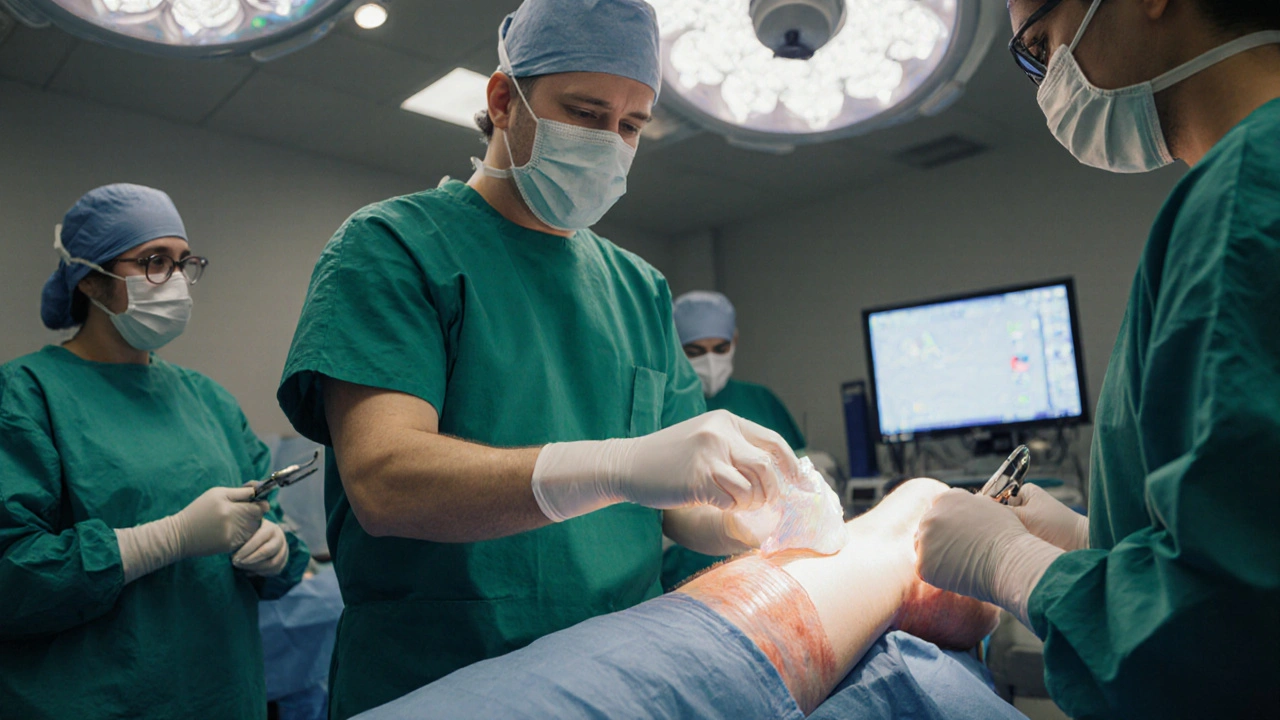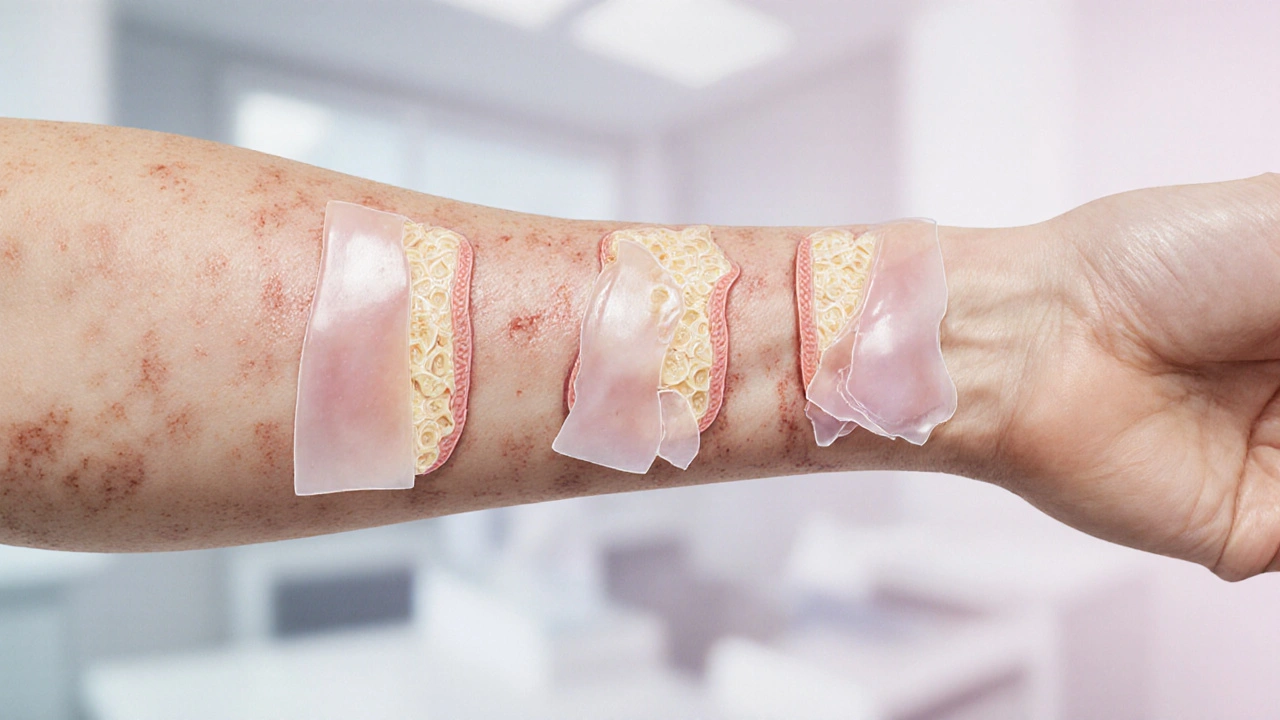Skin Grafting for Scar Revision: Step‑by‑Step Guide

Quick Takeaways
- Skin grafting replaces scarred tissue with healthy skin from another body area.
- Two main graft types: split‑thickness (STSG) and full‑thickness (FTSG).
- The procedure involves donor‑site harvest, graft placement, and meticulous post‑op dressing.
- Healing takes 2-3 weeks for graft take, plus months for scar remodeling.
- Complications like infection or graft loss are rare when after‑care guidelines are followed.
When a scar sticks out, tightens or discolors a skin’s appearance, many turn to Skin Grafting for Scar Revision a surgical method that moves healthy skin to replace scar tissue and improve texture and colour. Below is the full rundown of what happens from the moment you walk into the operating theatre to the weeks after the stitches come out.
What Exactly Is Skin Grafting?
In plain terms, a skin graft is a piece of skin taken from a healthy spot on your body (the donor site) and transplanted onto a scarred area (the recipient site). The graft brings its own blood supply; once it ‘sticks’, new vessels grow from the wound bed and the graft becomes part of the surrounding skin.
Two families dominate the field:
- Split‑Thickness Skin Graft (STSG) includes the epidermis and part of the dermis, making it thin and flexible
- Full‑Thickness Skin Graft (FTSG) contains the entire epidermis and dermis, giving a thicker, more durable result
When Do Surgeons Choose Grafting for Scar Revision?
Not every scar needs a graft. You’ll usually hear about it when:
- The scar is deep, contracture‑type, or adherent to underlying tissue.
- Previous excision left a defect too large to close primarily.
- The scar’s colour or texture differs dramatically from surrounding skin.
Plastic surgeons and dermatologists assess the scar’s size, location, and the patient’s overall health before deciding if the benefits outweigh the inconvenience of a donor‑site wound.
Choosing Between Split‑Thickness and Full‑Thickness Grafts
Both grafts have pros and cons. Your surgeon will match the graft type to the scar’s depth, the area’s flexibility needs, and aesthetic goals.
| Feature | Split‑Thickness (STSG) | Full‑Thickness (FTSG) |
|---|---|---|
| Thickness | 0.008-0.012in (0.2-0.3mm) | 0.04-0.06in (1-1.5mm) |
| Donor‑Site Healing | Regenerates within 1-2weeks | Requires primary closure; heals slower |
| Colour Match | Good for large areas, may be lighter | Better match for facial or exposed sites |
| Contracture Risk | Higher due to thinner dermis | Lower; provides more structural support |
| Typical Uses | Burns, large defects, lower extremities | Facial reconstruction, hand surgery, aesthetic revisions |

The Surgical Journey: Step‑by‑Step
Below is a road‑map of the operating day. Most steps happen in a single session lasting 1-3hours, depending on graft size.
- Pre‑operative assessment - Blood work, anesthesia clearance, and a walk‑through of the donor and recipient sites. Patients are asked to stop smoking at least two weeks prior, because nicotine hampers blood flow.
- Anesthesia - Usually a combination of a local nerve block for the donor area and a short‑acting general anesthetic for the recipient site, especially on the face.
- Donor‑site preparation - The surgeon selects a hidden area (often the thigh for STSG, or the inner arm/upper chest for FTSG). Using a dermatome-a precise blade‑controlled instrument-the required skin thickness is harvested.
- Harvesting the graft - The harvested sheet is placed on a sterile gauze soaked in saline. For larger grafts, the sheet may be meshed (tiny interlocking openings) to increase coverage and allow fluid drainage.
- Recipient‑site preparation - Scar tissue is excised down to healthy bleeding tissue, creating a vascular bed ready to accept the graft.
- Graft placement - The graft is gently laid onto the wound, trimmed to fit, and secured with fine sutures or staples. Vacuum‑Assisted Closure (VAC) a negative‑pressure dressing that improves graft adherence and reduces edema is often applied over the site.
- Dressing and immobilization - A non‑adhesive silicone layer, followed by a sterile gauze pack, keeps the graft moist. The limb may be splinted to prevent movement that could shear the graft.
- Post‑operative monitoring - Nurses check graft colour every few hours. A pink, slightly glistening surface signals good perfusion, while a pale or mottled look may signal failure.
Recovery: What Happens After the Sutures Come Out?
The first two weeks are crucial. The graft establishes its own blood supply-a process called ‘revascularisation.’ During this window, patients should:
- Keep the dressing dry; a waterproof cover is useful for showering.
- Avoid direct pressure or friction on the graft.
- Follow a protein‑rich diet to fuel tissue repair.
By week three, most grafts are fully integrated. The donor site for an STSG will have peeled like a sunburn and typically resolves without scarring. Full‑thickness donor sites may need a separate scar‑minimising protocol, such as silicone sheeting.
Long‑term scar remodeling can take up to a year. Gentle massage, sunscreen, and occasional laser resurfacing help the new skin blend with surrounding tissue.
Complications and How to Avoid Them
Serious issues are uncommon, but it’s good to know the red flags:
- Infection - Redness, swelling, or pus. Prevent by keeping the graft covered and using prophylactic antibiotics as prescribed.
- Partial graft loss - Patchy darkening may indicate inadequate blood flow. Early detection lets the surgeon perform a bedside debridement and re‑graft if needed.
- Hyperpigmentation - The graft may appear darker initially; sun protection reduces long‑term colour mismatch.
- Donor‑site morbidity - Pain or delayed healing. Proper immobilisation and moisture‑rich dressings help.
Following the surgeon’s after‑care checklist usually prevents these problems.
Questions You Might Still Have

Frequently Asked Questions
How long does a skin graft stay in place?
The graft adheres permanently once revascularisation completes, usually within 10-14days. The scar will keep remodeling for months afterward.
Can I see the scar before the graft is placed?
Yes. Surgeons often take a photo of the defect after excision to give you a realistic view of the final result.
Is the donor‑site painful?
Mild discomfort is normal for the first few days. Pain medication and cool compresses keep it manageable.
Will the graft match my skin tone?
A split‑thickness graft may appear slightly lighter initially, but it usually settles to a close match. Full‑thickness grafts give the best colour and texture match, especially on the face.
How soon can I return to work?
If your job is sedentary, many patients resume within a week. Physically demanding roles may need 2-4weeks to protect the graft and donor site.
Are there non‑surgical alternatives?
For mild scars, laser resurfacing, silicone sheets, or steroid injections can improve appearance, but they won’t replace scar tissue the way a graft does.
Skin grafting isn’t a quick fix, but when done right it transforms a stubborn scar into smooth, supple skin that blends with the surrounding area. Talk to a board‑certified plastic surgeon about whether this technique fits your scar‑revision goals, and follow the after‑care plan to keep complications at bay.

siddharth singh
September 28, 2025 AT 09:53Skin grafting is a nuanced surgical technique that demands meticulous planning from the outset. The first step involves a comprehensive pre‑operative assessment, including blood work and a detailed evaluation of the scar’s dimensions. Patients must cease smoking at least two weeks prior, because nicotine impairs neovascularisation, which is crucial for graft survival. During anesthesia, surgeons often employ a combined approach: a local nerve block for the donor site and a brief general anesthetic for the recipient area, especially when the face is involved. Selecting an appropriate donor site is vital; common choices include the lateral thigh for split‑thickness grafts and the inner arm or upper chest for full‑thickness grafts. The dermatome, a precision instrument, is calibrated to harvest skin at the exact thickness required, typically 0.2‑0.3 mm for STSG and 1‑1.5 mm for FTSG. Once harvested, the graft is kept moist on saline‑soaked gauze to preserve cellular viability until placement. On the recipient side, the scar tissue is excised down to a bleeding, well‑vascularised wound bed, which fosters graft adherence. The graft is then carefully trimmed to match the defect, positioned without tension, and secured with fine sutures or staples. Many surgeons now augment this step with a negative‑pressure wound therapy dressing, which improves graft take by reducing shear forces and edema. Post‑operatively, nursing staff monitor graft colour every few hours; a pink, glistening surface indicates adequate perfusion, whereas pallor may herald vascular compromise. Patients are instructed to keep the dressing dry, use waterproof covers when showering, and avoid pressure or friction on the graft for the first two weeks. Nutrition also plays a pivotal role, with a protein‑rich diet supporting collagen synthesis and overall tissue repair. By the end of the third week, most grafts have achieved revascularisation and are considered fully integrated. The donor site of an STSG typically re‑epithelialises within 10‑14 days, resembling a superficial sunburn that resolves without significant scarring. Full‑thickness donor sites, however, may require primary closure and a subsequent scar‑minimisation protocol such as silicone sheeting or laser resurfacing. Long‑term outcomes continue to evolve for up to a year, with gentle massage, diligent sunscreen use, and occasional laser treatments helping the graft blend seamlessly with surrounding skin.
Angela Green
October 5, 2025 AT 08:33While the guide is generally spot‑on, there are a few grammatical hiccups worth noting; for example, “the graft adheres permanently once revascularisation completes” would read more smoothly as “the graft adheres permanently once revascularisation has completed.” Additionally, “donor‑site morbidity” should be hyphenated consistently throughout the article. The use of “etc.” is absent, which is appropriate in a medical piece, but the occasional “i.e.” could be replaced with “that is” for clarity. I also noticed inconsistent capitalization of “Full‑Thickness” versus “full‑thickness”; standardizing to lowercase after the initial mention improves readability. Lastly, the phrase “skin grafting isn’t a quick fix” could be tightened to “skin grafting is not a quick fix” to maintain formal tone. Overall, brilliant effort-keep polishing!
April Malley
October 12, 2025 AT 07:13Wow!!! This post really breaks down the whole grafting process in a way that even my grandma could follow,,, and that’s saying something!!! I love how the step‑by‑step list is paired with clear bullet points,,, plus the tables are super helpful!!! If anyone’s thinking about going for a graft, just remember to follow the after‑care checklist to the letter!!! And don’t forget, staying hydrated and eating plenty of protein can make a world of difference!!!
scott bradshaw
October 19, 2025 AT 05:53Oh great another “miracle cure” for scars, because we all know surgery never has complications.
Crystal Price
October 26, 2025 AT 03:33In the grand theater of skin, a graft is the understudy that steps into the spotlight, yet many forget the price of that applause; the truth is, without dedication to post‑op care, the performance falls flat.
Murhari Patil
November 2, 2025 AT 02:13Listen up, they don’t tell you that the real reason surgeons push grafts is to keep the medical industry rolling in profit, all while hiding the fact that natural scar remodeling works just as well if you avoid the pharma‑laden dressings.
kevin joyce
November 9, 2025 AT 00:53From a regenerative medicine standpoint, the interplay between angiogenesis and extracellular matrix remodeling dictates graft integration; empathically speaking, patients should view each postoperative check as a collaborative dialogue with their own biology, where supportive nutrition and stress reduction act as silent co‑surgeons, enhancing neo‑vascular networks and ultimately sculpting a seamless scar continuum.
Beth Lyon
November 15, 2025 AT 23:33i think the guide is pretty helpful just watch out for the donor site pain its real but manageable.
Nondumiso Sotsaka
November 22, 2025 AT 22:13Hey there! Remember, each step in the grafting journey is a chance to learn and grow 😊 Stay patient with the healing timeline, keep up with moisturizing the donor site, and don’t hesitate to reach out to your surgeon if anything feels off. You’ve got this!
Ashley Allen
November 29, 2025 AT 20:53Follow the after‑care checklist meticulously.
Brufsky Oxford
December 6, 2025 AT 19:33In the echo of each stitched line lies a reminder that our bodies are narratives constantly being edited; embrace the process and smile :) .